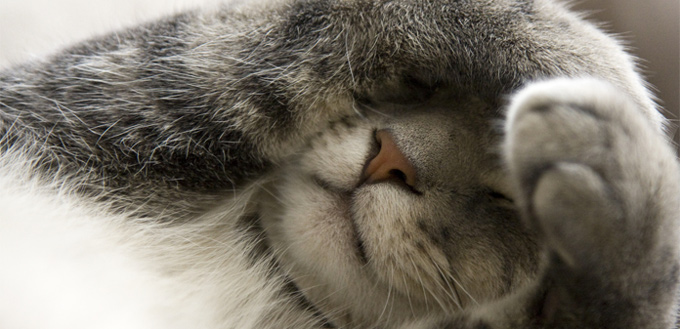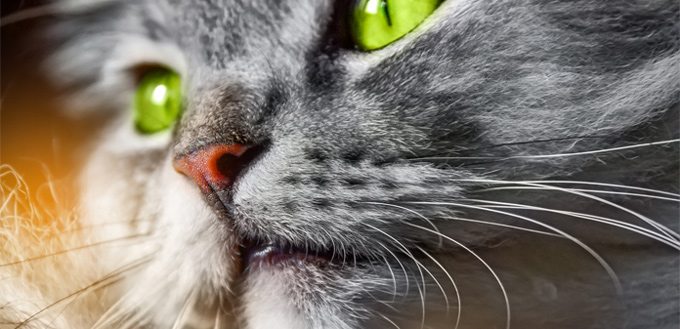Some people refer to a cat’s whiskers as being something like a beard, or a moustache. This isn’t quite true. A cat’s whiskers have many purposes, and are incredibly useful assets for your cat, and not so much of a fashion statement. Although, they do look really cute!
Whiskers Have Many Names
Most of us use the term whiskers, but they can also be known by their proper name, vibrissae, or by the term ‘tactile hairs’. Vibrissae is also the name for the hairs inside the nostrils of people. Vibrissae grow in groups, with an ordered arc pattern. While most hair is made from keratin, vibrissae are different. They grow from a special hair follicle.

How Many Whiskers Does a Cat Have?
Your cat will have between eight and twelve whiskers on the sides of his nose. But, that’s not his only whiskers. He’ll also have some on his chin, above his eyes, and on the back of the lower part of his front legs, but these are much shorter. The whiskers are much deeper rooted in the skin than his regular hair, and the area where the roots are is more generously supplied with veins and nerves. This means that the whiskers have incredible sensitivity. However, like hair, and nail, whiskers can fall out, but they will regrow naturally.
What Do Whiskers Do?
Your cat’s whiskers do many things, from acting as a ruler, to helping him communicate. They’re actually one of the most important assets he has.
- Measurement
Cats have interesting anatomy that has evolved to help them be exceptionally skilled hunters. One part of this is being able to fit through narrow spaces. Your cat’s whiskers will be roughly the same width as his body. You might notice if he finds a tight space that he puts his head in and out a few times first, because he’s using his whiskers to judge if the rest of his body will fit through.
He’ll also be working out if he can twist and manipulate his body to fit through the opening. Cats don’t have a collarbone like we have. They have a free floating clavicle, which allows them to twist into positions that we would never be able to. This bone structure also lets them fit into basically any opening that they can fit their head into.
Cats also use their whiskers as a visual measurement for jumping from ledge to ledge, and for climbing. You may notice him pausing before making a jump, which is when he’s working out if such a jump is possible.
- Navigation
Whiskers are incredibly sensitive and can detect even the slightest change in the direction of a breeze. This ability is an amazing asset for a predatory animal. He can use this to navigate hid way around even in the dark. You may wonder how your cat can find his way around your house, even in the dark of night. He uses his whiskers to detect the air current in the room. The position of the furniture will change the air current, so he can easily move from room to room without bumping into anything, unlike people, who are almost guaranteed to stub a toe!
- Prey Finding
As well as navigation, whiskers act in a similar manner when your cat is locating prey. Cats have incredible long distance eyesight, so spotting a prey animal from far away is usually very easy for them. However, their short distance eyesight isn’t as good, and the whiskers make up for it. They tend to use the whiskers on the backs of the lower front legs to help determine if the prey animal is in the right position for a successful pounce. They do use the other whiskers on the sides of the nose, the chin, and above the eyes for this as well, but not as much as the ones on their legs.
- Communication
The whiskers are also an indication of the cat’s mood. You do need to look at them in addition to the rest of his body language, but they can be a good indicator of how he’s feeling.
- If the whiskers are flat back against his face, then he’s probably angry, upset, or feeling threatened or scared.
- If his whiskers are still, and in a sort of default position, then he’s feeling relaxed, content and happy.
- If his whiskers are pointed forward, and you’re playing with him, then this is probably his hunting face.
- If the whiskers, and all his other hairs, are standing on end, then something has startled him, or caught his attention. You might notice him looking intently in one direction, or even taking steps towards it.

Grooming the Whiskers
You should never groom your cat’s whiskers. Some breeds have curly whiskers, and you should not straighten them. Some whiskers are longer than others, and you should not trim, or cut them. Straightening, trimming, or cutting the whiskers will leave your cat disorientated, frightened, and unable to function as he should be able to. He may show signs of dizziness and confusion. The whiskers will grow back, but as they shed and regrow naturally, they should be left to do so. There is absolutely no reason for the whiskers to be groomed at all, including the ones on his chin, above his eyes, and on the lower parts of his back legs.
As Your Cat Ages
As your cat ages, you may notice a few gray hairs in among his fur. This may be much more noticeable on a dark colored cat, but you might be able to see a difference in hair color in a lighter colored cat as well. Graying is completely normal, and you might even notice that one or two of his normally dark colored whiskers have turned gray, just like people do.
Sources:
- Suz Redfearn, Why Do Cats Have Whiskers?, WebMD
- Lynn Buzhardt, DVM, Why Do Cats Have Whiskers?, VCA Hospitals
Note: The advice provided in this post is intended for informational purposes and does not constitute medical advice regarding pets. For an accurate diagnosis of your pet's condition, please make an appointment with your vet.







